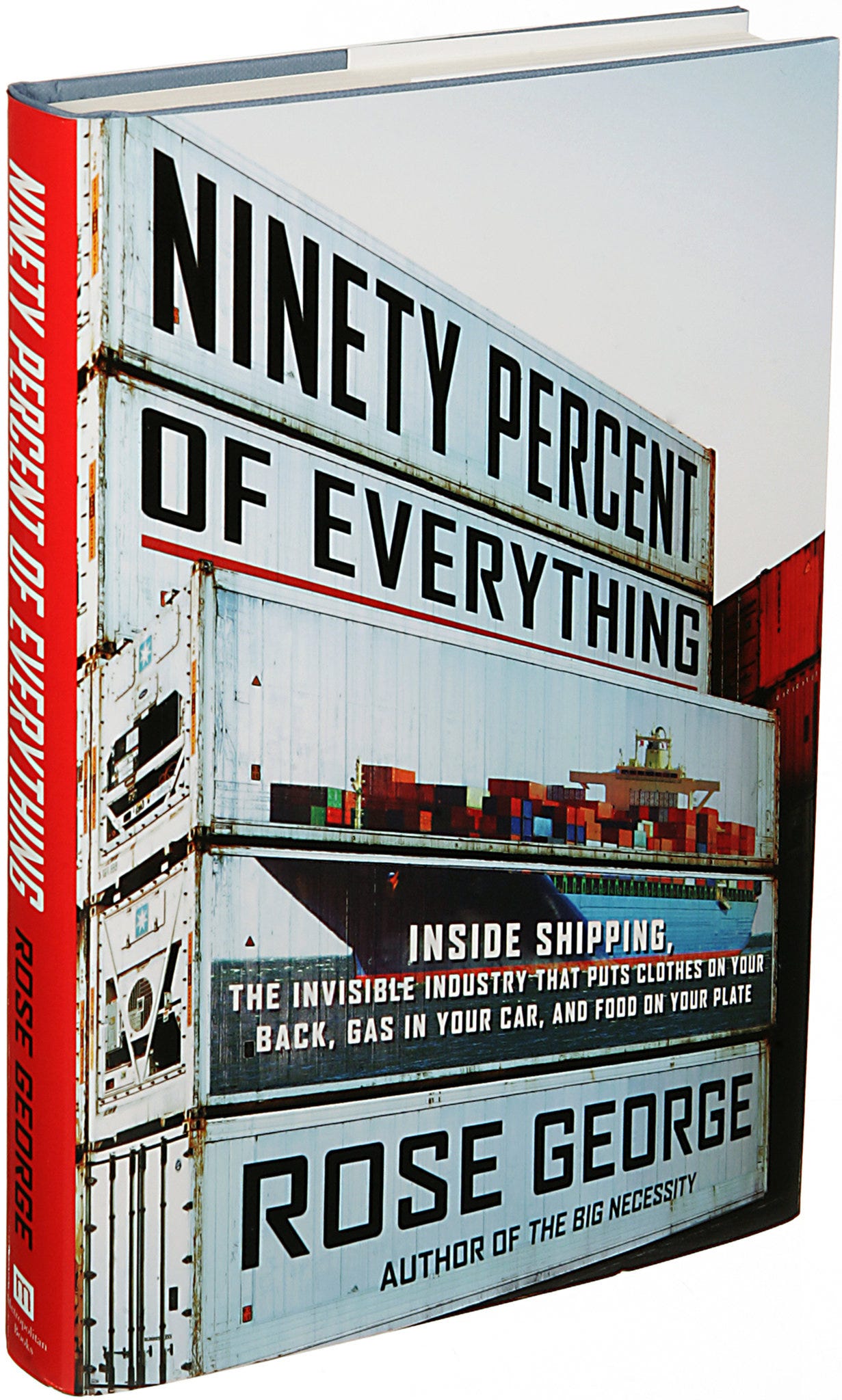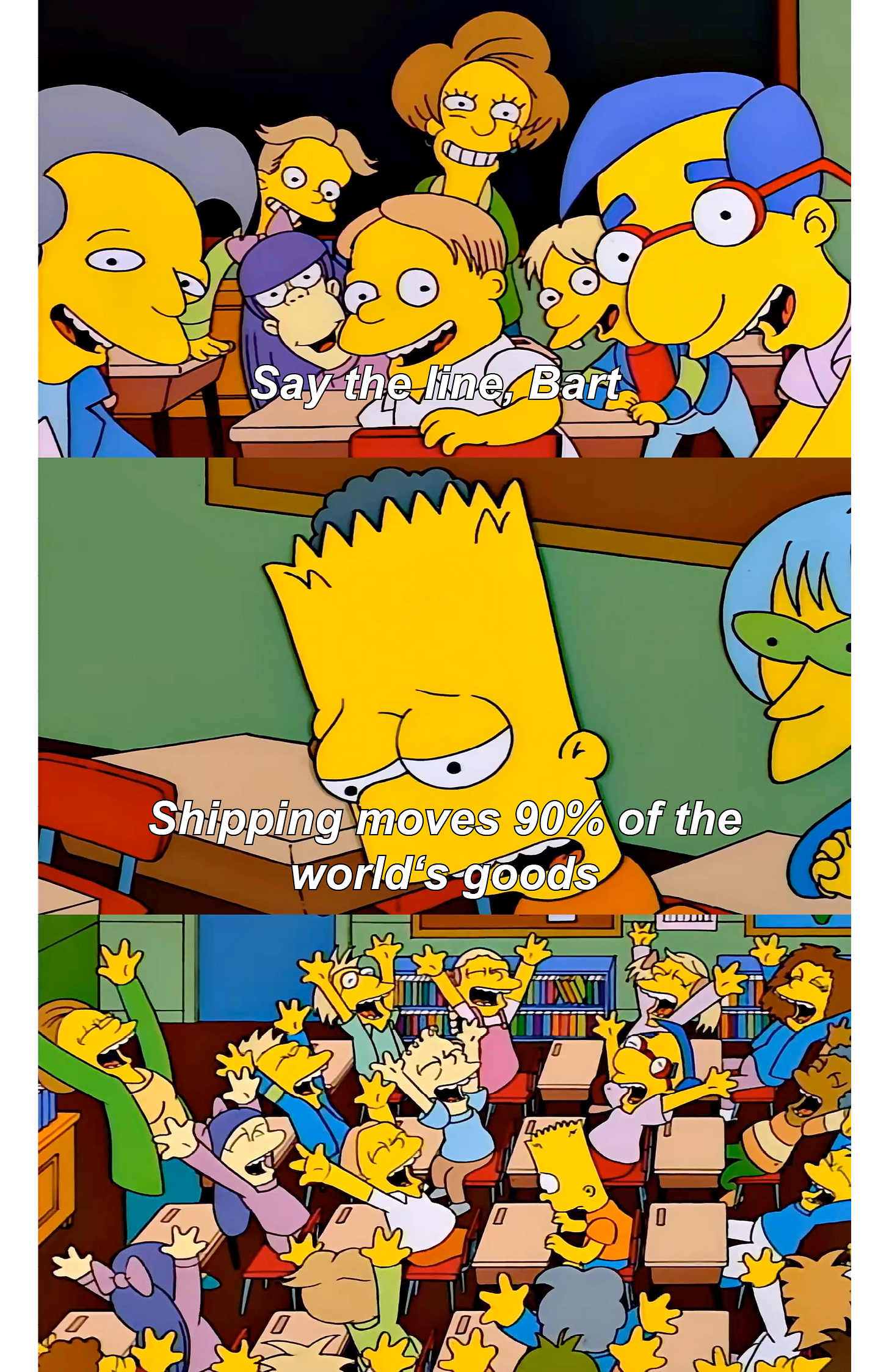90% of the World’s Goods are Moved By Sea. Says Who?
If you’ve ever read anything about shipping then you will have read some variation of the lines “Shipping is the backbone of the world economy. 90% of the world’s goods are moved by sea.” This line – and in particular the 90% stat – is generally rolled out as a shorthand way to prove how crucial maritime transport is to the functioning of everything today. For example, here’s the World Economic Forum saying it:
Source: World Economic Forum
Here’s the Organisation for Economic Co-operation and Development:
Source: OECD
And here’s the International Maritime Organisation:
Source: IMO.org
It was even used as the title of a 2013 book, “Ninety Percent of Everything: Inside Shipping, the Invisible Industry That Puts Clothes on Your Back, Gas in Your Car, And Food on Your Plate”
It’s hard to come up with another one-liner that so neatly establishes the centrality of maritime transport to the machinery of the world economy today. This is a stat that is repeated so often, is so central to how shipping understands and presents itself, that it no longer needs citation. Which is a problem, because a) if it ever was true, it’s almost definitely not today and b) it’s unclear where it actually comes from.
More than 100% of Everything
First off: what is this stat even actually saying? Is it saying that 90% of all traded goods are moved by sea – as the World Economic Forum puts it? Or just 90% of international trade – as OECD (WEF’s source) puts it? Because these are very different claims. Additionally, the statistic is referring to volume of goods rather than value, but that’s not immediately clear in the way its often presented. These, too, are very different claims: 10 tonnes of sand is a very different thing to, say, 10 tonnes of laptops.
On top of that, nothing is moved exclusively by ship. Generally, things arrive at ports to get loaded onto ships by truck, rail, or – in the case of oil and gas – pipeline. Let’s say that 40% of goods arrive to port by truck (they don’t, but we’ll get onto that later). How does this 40% then get calculated alongside the supposed 90% of seaborne goods? The answer is: it doesn’t, and statistics on international trade by transport type will never add up to a neat 100% because supply chains are convoluted things that generally involve many steps.
Let’s take the most traded commodity by volume – sand – and think about how it moves. Let’s say it’s loaded onto a truck and driven to a railway, where it’s loaded onto a train and taken to a port, that then loads it into a ship by crane, that then moves it to a port 3000 miles away, where it is loaded back onto a train before eventually reaching another truck that drives it to its destination. That sand has then gone through 5 different modes of transport (7 if we count the cranes at each port, and why not). If we take the “90% of international goods” stat to mean “90% of things moved internationally have at some point been on a ship”, then we could also say that X% have been on trucks, or railways, or pipelines, meaning that we obviously end up with a total way more than 100%.
It’s interesting to note that it’s not easy to find “X% of everything” statistics for trucking or rail. One reason for this may be that a ship is conducive to thinking about and measuring weight in a way that other forms of transport are not. A ship can act as a massive scale – it has a maximum weight (expressed in deadweight tonnage, or DWT), which can be relatively easily measured against based on how deep the ship sits in the water, known as a ship’s ‘draught’. The same cannot be easily said for trucks or trains. Adequately comprehensive data on the tonnage of world transport carried by truck is non-existent. The closest we have is data on land freight volumes from the 74 member states of the International Transport Forum, viewable here. The bottom line is that is obviously not possible to actually account for the weight of every single thing that moves by every transport system – especially when that would mean things in most cases getting double, triple or quadruple counted.
Around 80% of Some Things
In a 2019 essay Kathryn Moeller writes about a stat that has become central to movements towards gender equality: “Women spend 90% of their income on their children, whereas men spend 30-40%”. The sources for this stat, she writes, are varied:
“The State Department cited the World Bank. The World Economic Forum cited the Nike Foundation. The Nike Foundation didn’t cite any study. Neither did the U.N.’s Food and Agriculture Organization. Melinda Gates has said it again and again, but has never cited a study.”
When she tracked the stat back to the World Bank and asked them about the research, they replied to say that verified data does not exist, and would remove the stat from their website. This is what is known as a ‘ghost statistic’ or ‘zombie statistic’. Could ‘Shipping moves 90% of the world’s trade’ be one?
When we originally set out to write about this statistic, we thought we would be writing about the fact that people have stuck with the 90% figure and are not citing the most recent numbers, which we thought could be found in the UNCTAD (UN Conference on Trade and Development)’s Review of Maritime Transport, published annually since 1968. The 2021 edition states that 80% of world trade is carried by sea, so we had initially imagined that we’d be looking into what might be the possible drivers of a decrease from 90% to 80%.
Given that this report is perhaps the most authoritative and comprehensive source of maritime trade statistics available, we had assumed that we would find the figure in there, as well as a more detailed breakdown of the methodology behind it. But once we started combing through the actual reports, we couldn’t find this statistic anywhere, despite the UNCTAD regularly using it in exec summaries on its website.
In fact, the first time UNCTAD mention this stat is in 2008. The ‘highlight’ section of the report reads:
“With more than 80% of international trade in goods being carried by sea, and an even higher percentage for the trade of most developing countries, the Review of Maritime Transport is an important source of information for a broad audience”
This is a departure from previous editions. The 2007 highlight section, for example, does not include the statistic, and instead merely claims to offer a “detailed account of the main development affecting world seaborne trade, freight markets and rates, ports”, et cetera.
This year 2008 marked – as the 2009 report puts it lightly – “a major turning point in the history of the world economy and trade”. Growth in world exports grew at a decelerating rate in 2008, and declined in 2009, resulting in much lower levels of seaborne trade. This was happening whilst hordes of new ships ordered in the halcyon days prior to the financial crash were materialising, prompting a crisis of oversupply – a dynamic that we’re actually seeing a repetition of today, which we explored in our essay for Weird Economies last year.
Aside from the UNCTAD reports, one source that has undoubtedly played a role in popularising this statistic is the book ‘Ninety Percent of Everything’ (2013) by journalist Rose George. You would think that if you wrote an entire book based on this statistic you might want to mention where that stat comes from, but we couldn’t find a reference for it anywhere in the book. Also, when it came out, the figure reported by UNCTAD for multiple years had been “more than” or “around” 80%, not actually 90%. Although, in fairness, “90% of everything” does have more of a ring to it than “80% of everything”.
Since the UNCTAD Review of Maritime Transport turns out not to be the original source, and – to the extent that their somewhat pithy ‘highlights’ or executive summaries count – has only ever said 80% and not 90%, we are left wondering where the 90% statistic comes from. We tried finding the earliest possible mention of the statistic which led us to:
A 2004 book Globalization and Maritime Power by Sam J. Tangredi, which states that “The maritime world can also be seen as a primary source - in recent parlance, a root cause - of globalization because it is the medium by which 90 percent of world trade (when measured by weight and volume) is transported.”
A 1998 working paper by Mark W. Zacher titled Uniting Nations: Global Regimes and the UN System, where the sentence “Ninety percent of world trade by weight moves by ship” appears in brackets, and without citation.
A 1987 report from a UN body for Latin America, titled ‘Basic concepts of Maritime Transport and its present status in Latin America and the Caribbean’, which states that “Over 90% of the foreign trade is carried by sea in all countries of Latin America and the Caribbean, except for Mexico, which has an extensive land border with the United States, and Bolivia, most of whose trade is with Argentina.”
We also found a closely related statistic that comes up in the mid-90s with the founding of the World Trade Organisation in 1995. As one of the first ever WTO overview reports states: “present membership accounts for more than 90 per cent of world trade.” (WT/TPR/OV/1, December 1995). This is one of the closest phrasings we can find to the (still completely unfounded) “Shipping moves 90% of world trade” stat. Could there be a case of a broken telephone line, with a broad-brush stat set up to make bold claims on the state of world trade moving and morphing as it’s repeated across UN white papers, World Bank reports and shipping company sales pitches?
The question all this raises for us is: What (apart from the obvious) was at stake for the shipping industry in 2008 that required it to find a way to claim its centrality to the world economy at a time when freight rates were crumbling? If it really was (and is) so central to the functioning of an economy stretched all over the globe, then why did it suddenly feel the need to make a sales pitch for itself? We’re looking forward to exploring this more.
///
Also, if you enjoyed this, please tell your friends! Our readership is still relatively tiny and we want to change that.








